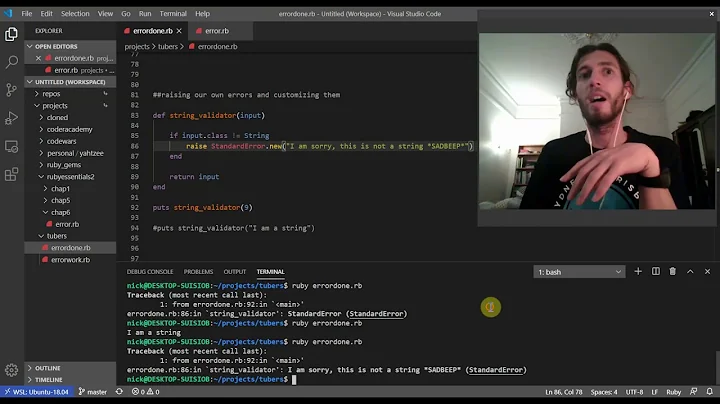What is the difference between Raising Exceptions vs Throwing Exceptions in Ruby?
Solution 1
I think http://hasno.info/ruby-gotchas-and-caveats has a decent explanation of the difference:
catch/throw are not the same as raise/rescue. catch/throw allows you to quickly exit blocks back to a point where a catch is defined for a specific symbol, raise rescue is the real exception handling stuff involving the Exception object.
Solution 2
-
raise,fail,rescue, andensurehandle errors, also known as exceptions -
throwandcatchare control flow
Unlike in other languages, Ruby’s throw and catch are not used for exceptions. Instead, they provide a way to terminate execution early when no further work is needed. (Grimm, 2011)
Terminating a single level of control flow, like a while loop, can be done with a simple return. Terminating many levels of control flow, like a nested loop, can be done with throw.
While the exception mechanism of raise and rescue is great for abandoning execution when things go wrong, it's sometimes nice to be able to jump out of some deeply nested construct during normal processing. This is where catch and throw come in handy. (Thomas and Hunt, 2001)
References
- Grimm, Avdi. "Throw, Catch, Raise, Rescue… I’m so Confused!" RubyLearning Blog. N.p., 11 July 2011. Web. 1 Jan. 2012. http://rubylearning.com/blog/2011/07/12/throw-catch-raise-rescue--im-so-confused/.
- Thomas, Dave, and Andrew Hunt. "Programming Ruby." : The Pragmatic Programmer's Guide. N.p., 2001. Web. 29 Sept. 2015. http://ruby-doc.com/docs/ProgrammingRuby/html/tut_exceptions.html.
Solution 3
https://coderwall.com/p/lhkkug/don-t-confuse-ruby-s-throw-statement-with-raise offers an excellent explanation that I doubt I can improve on. To summarize, nicking some code samples from the blog post as I go:
raise/rescueare the closest analogues to thethrow/catchconstruct you're familiar with from other languages (or to Python'sraise/except). If you've encountered an error condition and you wouldthrowover it in another language, you shouldraisein Ruby.-
Ruby's
throw/catchlets you break execution and climb up the stack looking for acatch(likeraise/rescuedoes), but isn't really meant for error conditions. It should be used rarely, and is there just for when the "walk up the stack until you find a correspondingcatch" behaviour makes sense for an algorithm you're writing but it wouldn't make sense to think of thethrowas corresponding to an error condition.What is catch and throw used for in Ruby? offers some suggestions on nice uses of the
throw/catchconstruct.
The concrete behavioural differences between them include:
-
rescue Foowill rescue instances ofFooincluding subclasses ofFoo.catch(foo)will only catch the same object,Foo. Not only can you not passcatcha class name to catch instances of it, but it won't even do equality comparisons. For instancecatch("foo") do throw "foo" endwill give you an
UncaughtThrowError: uncaught throw "foo"(or anArgumentErrorin versions of Ruby prior to 2.2) -
Multiple rescue clauses can be listed...
begin do_something_error_prone rescue AParticularKindOfError # Insert heroism here. rescue write_to_error_log raise endwhile multiple
catches need to be nested...catch :foo do catch :bar do do_something_that_can_throw_foo_or_bar end end A bare
rescueis equivalent torescue StandardErrorand is an idiomatic construct. A "barecatch", likecatch() {throw :foo}, will never catch anything and shouldn't be used.
Related videos on Youtube
Nick Retallack
Updated on January 09, 2020Comments
-
 Nick Retallack over 4 years
Nick Retallack over 4 yearsRuby has two different exceptions mechanisms: Throw/Catch and Raise/Rescue.
Why do we have two?
When should you use one and not the other?
-
 Franklin Yu about 5 years“getting out of nested loops” is a common need in many programming languages. Besides the
Franklin Yu about 5 years“getting out of nested loops” is a common need in many programming languages. Besides thegotoin C/C++ as @docwhat has mentioned, Java has labeled break and continue. (Python also has a rejected proposal for this.)
-
-
Denis de Bernardy almost 13 yearsCurious to know... Reading this from an iPad, so can't test them in 1.9, but some of those gotchas are no longer valid in recent ruby versions, right?
-
docwhat over 12 yearsAlso worth knowing:
raiseis very expensive.throwis not. Think ofthrowas usinggototo get out of a loop. -
docwhat over 12 years@Denis Which gotchas are you referring to?
-
 hrdwdmrbl about 11 yearsAvdi does not look like he sounds in podcasts.
hrdwdmrbl about 11 yearsAvdi does not look like he sounds in podcasts. -
Dennis over 9 yearsThe Ruby Learning link doesn't seem to work. Here's another blog post that discusses the differences: danielchangnyc.github.io/blog/2013/10/23/throw-raise
-
Jared Beck over 9 yearsFunny, rubylearning.com thinks that Avdi's article is still there. I guess that's why we copy stuff over to SO, so it won't be lost!
-
 wired00 over 8 yearsGood explanation but begs the question, why on earth would they design raise in ruby = throw in other language. and then also include throw but it != throw in other languages. I can't see their original logic there
wired00 over 8 yearsGood explanation but begs the question, why on earth would they design raise in ruby = throw in other language. and then also include throw but it != throw in other languages. I can't see their original logic there -
 Mark Amery over 8 years@wired00 (Shrug.) I agree that it seems pretty eccentric compared to other popular languages today.
Mark Amery over 8 years@wired00 (Shrug.) I agree that it seems pretty eccentric compared to other popular languages today. -
Jörg W Mittag almost 6 years@wired00: It has been called "raising" an exception ever since the very first experiments with structured error handling in the 1960s, it is called "raising" an exception in the seminal articles that invented the modern form of exception handling, it is called "raising" an exception in Lisps and Smalltalks, which were some of the main inspirations for Ruby, and it is called "raising" an exception or "raising" an interrupt in hardware, where the concept existed even before the concept of a "programming language" existed. The question should rather be: why did those other languages change that?
-
Jörg W Mittag almost 6 years@MarkAmery: Remember that many of those "other popular languages" are younger than Ruby or at least contemporary. So, the question should rather be: why did those other languages not follow Ruby (and Smalltalk and Lisp and hardware and the literature).
-
 Mark Amery almost 6 years@JörgWMittag Interesting - you inspired me to do a little historical research. C++ had the notion of "throwing" an exception years before Ruby came along, and per english.stackexchange.com/a/449209/73974 the term actually goes back to the 70s... so I think we still get to criticise Ruby for taking established terminology and using it to mean something completely different.
Mark Amery almost 6 years@JörgWMittag Interesting - you inspired me to do a little historical research. C++ had the notion of "throwing" an exception years before Ruby came along, and per english.stackexchange.com/a/449209/73974 the term actually goes back to the 70s... so I think we still get to criticise Ruby for taking established terminology and using it to mean something completely different. -
 morhook over 5 yearsThe link is broken!
morhook over 5 yearsThe link is broken! -
 Franklin Yu about 5 yearsSee ruby catch-throw and efficiency to understand more about the performance difference.
Franklin Yu about 5 yearsSee ruby catch-throw and efficiency to understand more about the performance difference.







